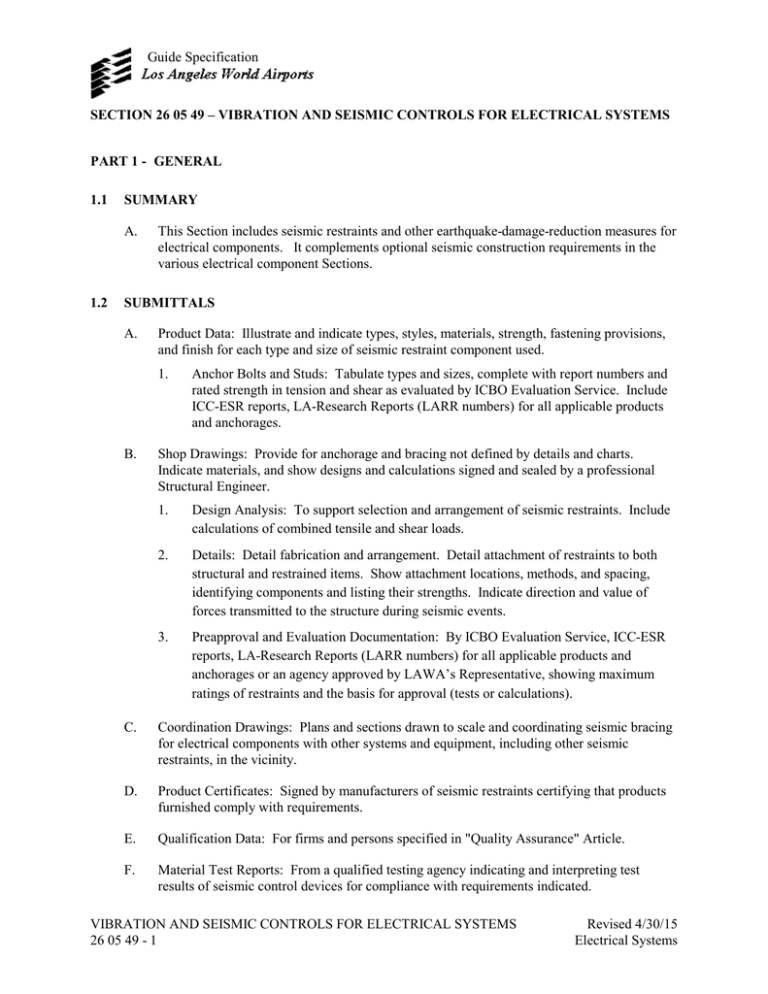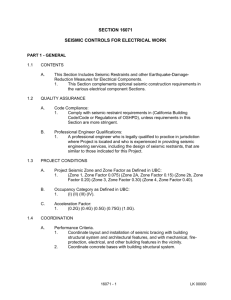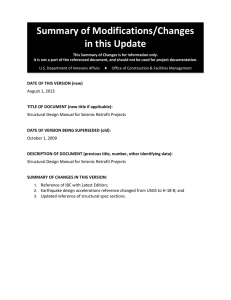SECTION 26 0549
advertisement

Guide Specification SECTION 26 05 49 – VIBRATION AND SEISMIC CONTROLS FOR ELECTRICAL SYSTEMS PART 1 - GENERAL 1.1 SUMMARY A. 1.2 This Section includes seismic restraints and other earthquake-damage-reduction measures for electrical components. It complements optional seismic construction requirements in the various electrical component Sections. SUBMITTALS A. Product Data: Illustrate and indicate types, styles, materials, strength, fastening provisions, and finish for each type and size of seismic restraint component used. 1. B. Anchor Bolts and Studs: Tabulate types and sizes, complete with report numbers and rated strength in tension and shear as evaluated by ICBO Evaluation Service. Include ICC-ESR reports, LA-Research Reports (LARR numbers) for all applicable products and anchorages. Shop Drawings: Provide for anchorage and bracing not defined by details and charts. Indicate materials, and show designs and calculations signed and sealed by a professional Structural Engineer. 1. Design Analysis: To support selection and arrangement of seismic restraints. Include calculations of combined tensile and shear loads. 2. Details: Detail fabrication and arrangement. Detail attachment of restraints to both structural and restrained items. Show attachment locations, methods, and spacing, identifying components and listing their strengths. Indicate direction and value of forces transmitted to the structure during seismic events. 3. Preapproval and Evaluation Documentation: By ICBO Evaluation Service, ICC-ESR reports, LA-Research Reports (LARR numbers) for all applicable products and anchorages or an agency approved by LAWA’s Representative, showing maximum ratings of restraints and the basis for approval (tests or calculations). C. Coordination Drawings: Plans and sections drawn to scale and coordinating seismic bracing for electrical components with other systems and equipment, including other seismic restraints, in the vicinity. D. Product Certificates: Signed by manufacturers of seismic restraints certifying that products furnished comply with requirements. E. Qualification Data: For firms and persons specified in "Quality Assurance" Article. F. Material Test Reports: From a qualified testing agency indicating and interpreting test results of seismic control devices for compliance with requirements indicated. VIBRATION AND SEISMIC CONTROLS FOR ELECTRICAL SYSTEMS 26 05 49 - 1 Revised 4/30/15 Electrical Systems Guide Specification 1.3 QUALITY ASSURANCE A. Comply with seismic restraint requirements in California Building Code/Code of Regulations, unless requirements in this Section are more stringent. B. Professional Engineer Qualifications: A professional Engineer who is legally qualified to practice in California and who is experienced in providing seismic engineering services, including the design of seismic restraints. C. Testing Agency Qualifications: An independent testing agency, acceptable to LAWA with minimum of 5 years experience. PART 2 - PRODUCTS 2.1 MANUFACTURERS A. 2.2 1. Caldyn. 2. Powerstrut. 3. Unistrut Corporation. MATERIALS A. 2.3 Manufacturers: Subject to compliance with requirements, provide products by one of the following: Use the following materials for restraints: 1. Indoor Dry Locations: Steel, zinc plated. 2. Outdoors and Damp Locations: Galvanized steel. 3. Corrosive Locations: Stainless steel. ANCHORAGE AND STRUCTURAL ATTACHMENT COMPONENTS A. Strength: Defined in reports by ICBO Evaluation Service or another agency acceptable to LAWA’s Representative. 1. Structural Safety Factor: Strength in tension and shear of components used shall be at least two times the maximum seismic forces to which they will be subjected. B. Concrete and Masonry Anchor Bolts and Studs: Steel-expansion wedge type. C. Concrete Inserts: Steel-channel type. D. Through Bolts: Structural type, hex head, high strength. Comply with ASTM A325. E. Welding Lugs: Comply with MSS SP-69, Type 57. VIBRATION AND SEISMIC CONTROLS FOR ELECTRICAL SYSTEMS 26 05 49 - 2 Revised 4/30/15 Electrical Systems Guide Specification 2.4 F. Beam Clamps for Steel Beams and Joists: Double sided. Single-sided type is not acceptable. G. Bushings for Floor-Mounted Equipment Anchors: Neoprene units designed for seismically rated rigid equipment mountings, and matched to the type and size of anchor bolts and studs used. H. Bushing Assemblies for Wall-Mounted Equipment Anchorage: Assemblies of neoprene elements and steel sleeves designed for seismically rated rigid equipment mountings, and matched to the type and size of attachment devices used. SEISMIC BRACING COMPONENTS A. Slotted Steel Channel: 1-5/8-by-1-5/8-inch cross section, formed from 0.1046-inch- thick steel, with 9/16-by-7/8-inch slots at a maximum of 2 inches o.c. in webs, and flange edges turned toward web. 1. Materials for Channel: ASTM A570, GR 33. 2. Materials for Fittings and Accessories: ASTM A575, ASTM A576, or ASTM A36. 3. Fittings and Accessories: Products of the same manufacturer as channels and designed for use with that product. 4. Finish: Galvanized, unless otherwise indicated. B. Channel-Type Bracing Assemblies: Slotted steel channel, with adjustable hinged steel brackets and bolts. C. Cable-Type Bracing Assemblies: Zinc-coated, high-strength steel wire rope cable attached to steel thimbles, brackets, and bolts designed for cable service. D. 1. Arrange units for attachment to the braced component at one end and to the structure at the other end. 2. Wire Rope Cable: Comply with ASTM 603. Use 49- or 133-strand cable with a minimum strength of 2 times the calculated maximum seismic force to be resisted. Hanger Rod Stiffeners: Slotted steel channels with internally bolted connections to hanger rod. PART 3 - EXECUTION 3.1 INSTALLATION A. Install seismic restraints according to applicable codes and regulations and as approved by the LAWA’s Representative, unless more stringent requirements are indicated. VIBRATION AND SEISMIC CONTROLS FOR ELECTRICAL SYSTEMS 26 05 49 - 3 Revised 4/30/15 Electrical Systems Guide Specification 3.2 3.3 STRUCTURAL ATTACHMENTS A. Use bolted connections with steel brackets, slotted channel, and slotted-channel fittings to spread structural loads and reduce stresses in accordance with the Structural Engineer of record approval. B. Attachments to New Concrete: Bolt to channel-type concrete inserts or use expansion anchors. C. Attachments to Existing Concrete: Use expansion anchors. In order to avoid severing any existing structural reinforcement, use ground penetrating radar or x-ray equipment to survey the existing concrete floor slabs/walls before cutting or drilling any new penetrations. D. Holes for Expansion Anchors in Concrete: Drill at locations and to depths that avoid reinforcing bars. E. Attachments to Solid Concrete Masonry Unit Walls: Use expansion anchors. F. Attachments to Hollow Walls: Bolt to slotted steel channels fastened to wall with expansion anchors. G. Attachments to Steel: Bolt to clamps on flanges of beams or on upper truss chords of bar joists. ELECTRICAL EQUIPMENT ANCHORAGE A. Anchor rigidly to a single mobile structural element or to a concrete base that is structurally tied to a single mobile structural element. B. Anchor panel boards, motor-control centers, motor controls, switchboards, switchgear, transformers, unit substations, fused power-circuit devices, transfer switches, busways, battery racks, static uninterruptible power units, power conditioners, capacitor units, communication system components, and electronic signal processing, control, and distribution units as follows: 1. Size concrete bases so expansion anchors will be a minimum of 10 bolt diameters from the edge of the concrete base. 2. Concrete Bases for Floor-Mounted Equipment: Use female expansion anchors and install studs and nuts after equipment is positioned. 3. Bushings for Floor-Mounted Equipment Anchors: Install to allow for resilient media between anchor bolt or stud and mounting hole in concrete. 4. Anchor Bolt Bushing Assemblies for Wall-Mounted Equipment: Install to allow for resilient media where equipment or equipment-mounting channels are attached to wall. 5. Torque bolts and nuts on studs to values recommended by equipment manufacturer. VIBRATION AND SEISMIC CONTROLS FOR ELECTRICAL SYSTEMS 26 05 49 - 4 Revised 4/30/15 Electrical Systems Guide Specification 3.4 3.5 SEISMIC BRACING INSTALLATION A. Install bracing according to spacing and strengths indicated by approved analysis. B. Expansion and Contraction: Install to allow for thermal movement of braced components. C. Cable Braces: Install with maximum cable slack recommended by manufacturer. D. Attachment to Structure: If specific attachment is not indicated, anchor bracing to the structure at flanges of beams, upper truss chords of bar joists, or at concrete members. ACCOMMODATION OF DIFFERENTIAL SEISMIC MOTION A. 3.6 Make flexible connections in raceways, cables, wire ways, cable trays, and busways where they cross expansion and seismic control joints, where adjacent sections or branches are supported by different structural elements, and where they terminate at electrical equipment anchored to a different mobile structural element from the one supporting them. FIELD QUALITY CONTROL A. Testing Agency: Engage a qualified testing agency to perform the following field qualitycontrol testing: B. Testing: Test pull-out resistance of seismic anchorage devices. 1. Provide necessary test equipment required for reliable testing. 2. Provide evidence of recent calibration of test equipment by a testing agency acceptable to LAWA’s Representative. 3. Schedule test with the LAWA Representative before connecting anchorage device to restrained component (unless post-connection testing has been approved), and with at least seven days' advance notice. 4. Obtain Structural Engineer’s approval before transmitting test loads to the structure. Provide temporary load-spreading members. 5. Test at least four of each type and size of installed anchors and fasteners selected by LAWA’s Representative. 6. Test to 90 percent of rated proof load of device. 7. If a device fails the test, modify all installations of same type and retest until satisfactory results are achieved. 8. Record test results. END OF SECTION 26 05 49 VIBRATION AND SEISMIC CONTROLS FOR ELECTRICAL SYSTEMS 26 05 49 - 5 Revised 4/30/15 Electrical Systems




